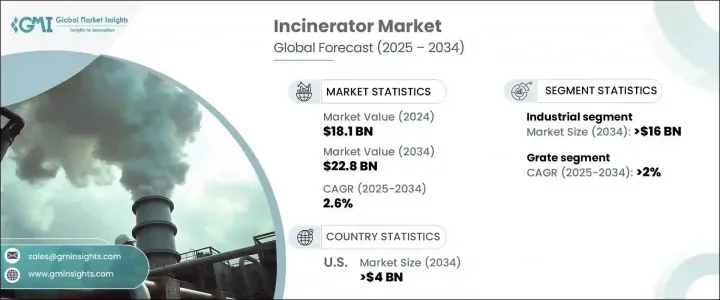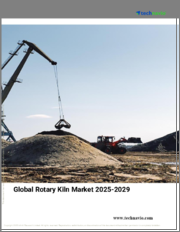
|
시장보고서
상품코드
1685107
소각로 시장 기회, 성장 촉진요인, 산업 동향 분석, 예측(2025-2034년)Incinerator Market Opportunity, Growth Drivers, Industry Trend Analysis, and Forecast 2025 - 2034 |
||||||
세계의 소각로 시장은 2024년에 181억 달러로 평가되었고 2025년부터 2034년에 걸쳐 CAGR 2.6%를 나타내 안정된 성장을 이룰 것으로 예측되고 있습니다.
이 성장의 주된 원동력은 환경 규정 준수를 중시하는 경향이 강해지고 있는 것으로, 세계 각국의 정부가 지속 가능한 폐기물 관리 관행을 채용하도록 기업에 일하는 정책을 제정하고 있습니다. 이러한 정책을 통해 기업은 엄격한 규제 요건을 준수하면서 소각로의 능력을 확대해야 합니다.

기업과 지역사회가 환경면에서의 이점을 인식하게 되면서 소각시스템에 대한 수요는 확대되고, 특히 소규모 용도에서는 현지 기업과 지자체에 있어서 소각시스템이 보다 친숙해지고 있습니다. 폐기물을 효과적으로 관리하면서 환경에 미치는 영향을 줄이는 것에 대한 관심이 높아짐에 따라 고급 소각 솔루션에 대한 수요가 증가하고 있습니다. 게다가 보다 깨끗하고 지속 가능한 실천을 위한 세계의 뒷받침은 폐기물 관리와 에너지 회수를 결합한 기술의 채용을 가속화하고 있으며, 폐기물 처리의 중요한 과제를 해결하면서 에너지 수요를 충족시키는 데 도움이 되고 있습니다.
| 시장 범위 | |
|---|---|
| 시작 연도 | 2024년 |
| 예측 연도 | 2025-2034년 |
| 시작 금액 | 181억 달러 |
| 예측 금액 | 228억 달러 |
| CAGR | 2.6% |
산업용 소각로 시장은 2034년까지 160억 달러 시장 규모에 이를 것으로 예측됩니다. 자동화와 첨단 모니터링 시스템의 통합으로 업무 효율성, 자산 관리, 안전성이 향상되고 산업이 혁신되고 있습니다. 이 기술 혁신은 또한 소각로가 엄격한 환경 규제를 충족하는 능력을 강화하고 다양한 산업에서의 채용을 지원합니다. 지속 가능한 운영 관행에 대한 관심 증가는 기업이 환경 기준을 준수하면서 폐기물 관리 프로세스의 합리화를 목표로 하는 이 부문의 성장에 기여하고 있습니다.
다양한 유형의 소각로 중에서 화격자 소각로 부문은 2034년까지 연평균 복합 성장률(CAGR) 2%를 나타낼 것으로 예상됩니다. 이 성장의 주요 원인은 폐기물 관리 및 에너지 회수 응용 분야에서 화격자 소각로의 사용 증가입니다. 화격자 소각로는 폐기물을 에너지로 변환하는 데 필수적이며 대체 에너지 원을 모색하고 재생 불가능한 자원에 대한 의존성을 줄이는 세계적인 노력과 일치합니다. 산업과 정부가 기후 변화와 싸우기 위해 보다 친환경적인 에너지 솔루션을 추구하는 가운데, 폐기물로부터 에너지를 생성하는 역할은 더욱 중요해지고 있으며, 이 부문의 확대에 더욱 기여하고 있습니다.
미국의 소각로 시장은 2034년까지 40억 달러를 창출할 것으로 예상됩니다. 급속한 도시화와 산업화는 폐기물 발생량 증가를 촉진하고, 효율적인 폐기물 관리 솔루션에 대한 임박한 요구를 창출하고 있습니다. 게다가 부적절한 폐기물 처리의 부정적인 영향에 대한 사회적 의식 증가는 폐기물을 효과적으로 관리할 뿐만 아니라 에너지 생산에도 기여하는 혁신적인 기술에 대한 수요를 부추기고 있습니다. 신재생에너지 발전으로의 세계 변화가 진행됨에 따라 폐기물 관리와 발전을 모두 가능하게 하는 소각로 수요가 증가하고 시장 성장을 더욱 향상시킬 것으로 예상됩니다.
목차
제1장 조사 방법과 조사 범위
- 시장 범위와 정의
- 시장 추계·예측 파라미터
- 예측 계산
- 데이터 소스
제2장 주요 요약
제3장 업계 인사이트
- 생태계 분석
- 규제 상황
- 업계에 미치는 영향요인
- 성장 촉진요인
- 업계의 잠재적 위험 및 과제
- 성장 가능성 분석
- Porter's Five Forces 분석
- PESTEL 분석
제4장 경쟁 구도
- 서론
- 전략적 전망
- 혁신 및 지속가능성의 전망
제5장 시장 규모와 예측 : 제품별(2021-2034년)
- 주요 동향
- 로터리 킬른
- 유동층
- 화격자
- 정적 화로
- 다중 화로
- 기타
제6장 시장 규모와 예측 : 최종 용도별(2021-2034년)
- 주요 동향
- 지자체
- 산업
제7장 시장 규모와 예측 : 지역별(2021-2034년)
- 주요 동향
- 북미
- 미국
- 캐나다
- 유럽
- 영국
- 프랑스
- 독일
- 이탈리아
- 스웨덴
- 네덜란드
- 러시아
- 아시아태평양
- 중국
- 호주
- 인도
- 일본
- 한국
- 중동 및 아프리카
- 카타르
- 아랍에미리트(UAE)
- 나이지리아
- 사우디아라비아
- 남아프리카
- 라틴아메리카
- 브라질
- 아르헨티나
- 멕시코
제8장 기업 프로파일
- Alfatherm
- Atlas Incinerators
- Babcock &Wilcox
- CHUWASTAR
- Dutch Incinerators
- ECO Concepts
- EEW Energy from Waste
- Gershma, Brickner &Bratton
- Haat Incinerator India
- Incinco
- Inciner8
- Keller Manufacturing
- Keppel Seghers
- Ketek Group
- MARTIN
- Maximus Envirotech
- MITSUBISHI HEAVY INDUSTRIES
- SUEZ
- Vikas Engineering
- Waste Spectrum
The Global Incinerator Market, valued at USD 18.1 billion in 2024, is projected to experience steady growth with a CAGR of 2.6% from 2025 to 2034. A key driver for this growth is the increasing emphasis on environmental compliance, with governments worldwide enacting policies that push businesses to adopt sustainable waste management practices. These policies are encouraging companies to scale up their incinerator capacities while adhering to stringent regulatory requirements.

As businesses and local communities become more aware of the environmental benefits, the demand for incineration systems is expanding, especially within small-scale applications, making them more accessible for local businesses and municipalities. The growing focus on reducing environmental impact while managing waste effectively is propelling the demand for advanced incineration solutions. In addition, the global push toward cleaner, more sustainable practices is accelerating the adoption of technologies that combine waste management with energy recovery, helping to meet energy needs while addressing critical waste disposal challenges.
| Market Scope | |
|---|---|
| Start Year | 2024 |
| Forecast Year | 2025-2034 |
| Start Value | $18.1 Billion |
| Forecast Value | $22.8 Billion |
| CAGR | 2.6% |
The industrial incinerator segment of the market is anticipated to generate USD 16 billion by 2034. Automation and the integration of advanced monitoring systems are transforming industries by improving operational efficiency, asset management, and safety. These innovations are also enhancing the ability of incinerators to meet stringent environmental regulations, supporting their adoption across various industries. The increased focus on sustainable operational practices is contributing to the growth of this segment as companies seek to streamline their waste management processes while adhering to environmental standards.
Among the various types of incinerators, the grate incinerator segment is expected to grow at a CAGR of 2% through 2034. This growth is primarily driven by the increasing use of grate incinerators in waste management and energy recovery applications. Grate incinerators are essential in converting waste into energy, aligning with global efforts to explore alternative energy sources and reduce reliance on nonrenewable resources. Their role in generating energy from waste is becoming more critical as industries and governments pursue greener energy solutions to combat climate change, further contributing to the expansion of this segment.
In the U.S., the incinerator market is projected to generate USD 4 billion by 2034. Rapid urbanization and industrialization are driving an increase in waste generation, creating a pressing need for efficient waste management solutions. Furthermore, heightened public awareness about the negative effects of improper waste disposal is fueling demand for innovative technologies that not only manage waste effectively but also contribute to energy production. As the global shift toward renewable energy continues, the demand for incinerators that can both manage waste and generate power is expected to increase, further boosting market growth.
Table of Contents
Chapter 1 Methodology & Scope
- 1.1 Market scope & definitions
- 1.2 Market estimates & forecast parameters
- 1.3 Forecast calculation
- 1.4 Data sources
- 1.4.1 Primary
- 1.4.2 Secondary
- 1.4.2.1 Paid
- 1.4.2.2 Public
Chapter 2 Executive Summary
- 2.1 Industry synopsis, 2021 - 2034
Chapter 3 Industry Insights
- 3.1 Industry ecosystem analysis
- 3.2 Regulatory landscape
- 3.3 Industry impact forces
- 3.3.1 Growth drivers
- 3.3.2 Industry pitfalls & challenges
- 3.4 Growth potential analysis
- 3.5 Porter's analysis
- 3.5.1 Bargaining power of suppliers
- 3.5.2 Bargaining power of buyers
- 3.5.3 Threat of new entrants
- 3.5.4 Threat of substitutes
- 3.6 PESTEL analysis
Chapter 4 Competitive Landscape, 2024
- 4.1 Introduction
- 4.2 Strategic outlook
- 4.3 Innovation & sustainability landscape
Chapter 5 Market Size and Forecast, By Product, 2021 – 2034 (USD Million)
- 5.1 Key trends
- 5.2 Rotary kiln
- 5.3 Fluidized bed
- 5.4 Grate
- 5.5 Static hearth
- 5.6 Multiple hearth
- 5.7 Others
Chapter 6 Market Size and Forecast, By End Use, 2021 – 2034 (USD Million)
- 6.1 Key trends
- 6.2 Municipal
- 6.3 Industrial
Chapter 7 Market Size and Forecast, By Region, 2021 – 2034 (USD Million)
- 7.1 Key trends
- 7.2 North America
- 7.2.1 U.S.
- 7.2.2 Canada
- 7.3 Europe
- 7.3.1 UK
- 7.3.2 France
- 7.3.3 Germany
- 7.3.4 Italy
- 7.3.5 Sweden
- 7.3.6 Netherlands
- 7.3.7 Russia
- 7.4 Asia Pacific
- 7.4.1 China
- 7.4.2 Australia
- 7.4.3 India
- 7.4.4 Japan
- 7.4.5 South Korea
- 7.5 Middle East & Africa
- 7.5.1 Qatar
- 7.5.2 UAE
- 7.5.3 Nigeria
- 7.5.4 Saudi Arabia
- 7.5.5 South Africa
- 7.6 Latin America
- 7.6.1 Brazil
- 7.6.2 Argentina
- 7.6.3 Mexico
Chapter 8 Company Profiles
- 8.1 Alfatherm
- 8.2 Atlas Incinerators
- 8.3 Babcock & Wilcox
- 8.4 CHUWASTAR
- 8.5 Dutch Incinerators
- 8.6 ECO Concepts
- 8.7 EEW Energy from Waste
- 8.8 Gershma, Brickner & Bratton
- 8.9 Haat Incinerator India
- 8.10 Incinco
- 8.11 Inciner8
- 8.12 Keller Manufacturing
- 8.13 Keppel Seghers
- 8.14 Ketek Group
- 8.15 MARTIN
- 8.16 Maximus Envirotech
- 8.17 MITSUBISHI HEAVY INDUSTRIES
- 8.18 SUEZ
- 8.19 Vikas Engineering
- 8.20 Waste Spectrum



















